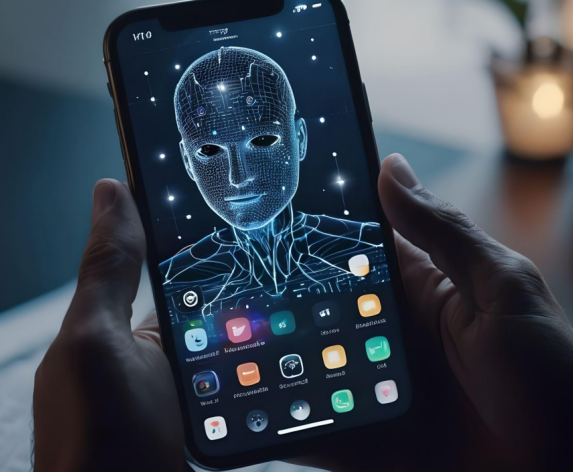Apple’s iPhone, since its inception in 2007, has continuously evolved, incorporating cutting-edge technology to enhance user experience. Among these advancements, the integration of artificial intelligence (AI) stands out, fundamentally transforming how users interact with their devices. This article explores the various Evaluation of AI features on the iPhone, their development, and the impact they have on everyday use.
Siri: The Pioneer of AI on iPhone
Introduced in 2011 with the iPhone 4S, Siri was one of the first AI features that showcased Apple’s commitment to integrating intelligent systems into its devices. Siri, a voice-activated personal assistant, revolutionized the way users could interact with their iPhones. Leveraging natural language processing (NLP), Siri could understand and respond to a variety of commands, from setting reminders to sending texts, and even answering trivia questions.
Over the years, Siri has become more sophisticated, incorporating machine learning to improve its accuracy and contextual understanding. Siri’s ability to handle complex queries, provide proactive suggestions, and integrate with third-party apps has significantly enhanced its utility.
Machine Learning and Core ML
With the launch of iOS 11 in 2017, Apple introduced Core ML, a machine learning framework that allows developers to integrate AI models into their apps seamlessly. Core ML marked a significant step forward, making the iPhone a powerful tool for running machine learning tasks directly on the device rather than relying solely on cloud-based services.
Core ML supports various machine learning models, including deep learning, decision trees, and linear models, enabling a wide range of applications. For instance, photo and video apps can use Core ML to perform real-time image recognition, augmented reality apps can deliver more immersive experiences, and health apps can provide personalized insights based on user data.
Face ID: Advanced Biometric Security
Face ID, introduced with the iPhone X in 2017, is another groundbreaking AI feature. Utilizing a sophisticated array of sensors and a neural engine, Face ID performs real-time facial recognition to unlock the device securely. This system maps the user’s face with over 30,000 invisible dots, creating a precise depth map and an infrared image.
The neural engine processes this data using machine learning algorithms, ensuring that Face ID adapts to changes in the user’s appearance over time, such as growing a beard or wearing glasses. Face ID not only enhances security but also adds convenience, allowing users to authenticate purchases, access secure apps, and even log into websites with a glance.
Photos and Camera Enhancements
The Photos app on the iPhone leverages AI to organize and enhance the user’s photo library. Features such as Memories and People & Places use machine learning to categorize photos by recognizing faces, scenes, and objects. This automatic organization makes it easier for users to find and relive their favorite moments.
The iPhone’s camera system is another area where AI plays a crucial role. Apple’s computational photography techniques, powered by the A-series chips, use machine learning to improve image quality. Features like Smart HDR, Deep Fusion, and Night mode analyze scenes and dynamically adjust settings to capture the best possible photo, even in challenging lighting conditions.
Deep Fusion, for instance, uses machine learning to perform pixel-by-pixel processing of photos, optimizing texture, details, and noise reduction. This results in images with greater clarity and detail, particularly in medium to low-light conditions.
Augmented Reality and ARKit
Apple’s ARKit, introduced with iOS 11, brings augmented reality (AR) capabilities to the iPhone, allowing developers to create immersive AR experiences. ARKit uses the iPhone’s camera, sensors, and machine learning algorithms to understand the environment and place digital objects in the real world.
Applications of AR on the iPhone range from gaming and entertainment to education and navigation. For example, users can visualize furniture in their homes before purchasing, engage in interactive learning experiences, or receive real-time directions overlaid on the real world.
Predictive Text and QuickType Keyboard
AI has also enhanced the typing experience on the iPhone through the QuickType keyboard. Predictive text, powered by machine learning, suggests words and phrases as users type, improving typing speed and accuracy. The keyboard learns from the user’s typing habits and adapts over time, offering personalized suggestions based on frequently used words and phrases.
Privacy and On-Device Processing
One of Apple’s key principles in implementing AI features is maintaining user privacy. Apple emphasizes on-device processing, ensuring that sensitive data remains on the device rather than being sent to the cloud. For instance, the neural engine performs complex computations for features like Face ID, Siri suggestions, and photo analysis directly on the iPhone.
This approach not only enhances privacy but also improves performance by reducing latency and reliance on internet connectivity. Users can enjoy intelligent features without compromising their personal data security.
Future Prospects
As AI continues to evolve, the potential for future iPhone features is vast. We can anticipate even more sophisticated personal assistants, enhanced AR experiences, and deeper integration of AI across various apps and services. Apple’s ongoing investment in AI research and development ensures that the iPhone will remain at the forefront of innovation, continually transforming how users interact with technology.
Intelligent Battery Management
One of the less conspicuous but highly impactful uses of AI on the iPhone is in battery management. Introduced with iOS 13, the iPhone’s battery optimization features leverage machine learning to understand user habits and optimize charging patterns accordingly.
The “Optimized Battery Charging” feature, for example, learns from the user’s daily charging routine and slows down the charging process to 80% until it predicts the user will need it. This prevents overcharging, which can degrade battery health over time. By managing how and when the battery is charged, AI helps extend the lifespan of the iPhone’s battery, ensuring it maintains capacity over the long term.
Enhanced Security Features
Beyond Face ID, AI contributes significantly to other security features on the iPhone. Apple’s commitment to user privacy is evident in its approach to data security, where AI algorithms play a crucial role. For instance, the iPhone uses on-device machine learning for processing sensitive information, which ensures that personal data remains secure and private.
The introduction of the Secure Enclave, a dedicated chip for secure processing, further highlights Apple’s focus on security. AI algorithms run on this chip to handle encryption and decryption processes, biometric authentication, and other sensitive operations without exposing data to potential breaches.
Personalization and Proactive Assistance
Apple has continuously improved how AI personalizes the user experience on the iPhone. Siri Suggestions, for instance, uses machine learning to provide timely and relevant recommendations. These suggestions might include calling a frequently contacted person at a specific time, opening an app you often use at a particular location, or even suggesting shortcuts for routine tasks.
The Shortcuts app takes this a step further by allowing users to create automated workflows. These workflows can be triggered by specific conditions, such as time of day, location, or even the state of other devices. The use of AI to predict and suggest these automations helps streamline tasks, saving time and enhancing productivity.
Enhanced Communication Features
AI significantly enhances communication on the iPhone. Features like voicemail transcription use machine learning to convert audio messages into text, making it easier for users to quickly scan through their voicemails.
In iMessage, predictive text and emoji suggestions have become more intuitive and context-aware thanks to AI. These features analyze the conversation’s context and suggest appropriate words or emojis, making communication more fluid and engaging.
Furthermore, AI-driven language translation in real-time within apps like Translate ensures that users can communicate effortlessly across different languages. The Translate app offers features like conversation mode, where AI helps facilitate a back-and-forth dialogue between speakers of different languages, demonstrating the seamless integration of AI into everyday communication.
Health and Fitness Insights
Apple’s Health app, coupled with the Apple Watch, exemplifies the integration of AI in health and fitness. Machine learning algorithms analyze data collected from various sensors to provide insights into users’ physical activity, sleep patterns, and overall health metrics.
For instance, the ECG app on the Apple Watch can detect irregular heart rhythms, potentially identifying conditions like atrial fibrillation. AI analyzes the ECG readings, providing users with actionable health information. Additionally, the watchOS updates have introduced features like blood oxygen monitoring and sleep tracking, which use machine learning to deliver personalized health insights and recommendations.
Environmental Impact and AI
Apple’s commitment to sustainability extends to its use of AI for environmental impact. For instance, the iPhone’s energy-efficient design and the integration of AI to manage resources help reduce the overall carbon footprint. AI-driven features optimize power usage, manage background tasks efficiently, and ensure that hardware components operate in an energy-efficient manner.
Moreover, Apple has been increasingly incorporating recycled materials in its products, and AI plays a role in the recycling process. Machine learning algorithms help sort and disassemble materials efficiently, ensuring that components can be reused or recycled with minimal waste.
AI Accessibility and Inclusion
Apple’s dedication to accessibility is reflected in the various AI-powered features designed to assist users with disabilities. VoiceOver, for example, uses AI to describe what is happening on the screen, making it possible for visually impaired users to navigate the iPhone effectively.
Similarly, the new features like sound recognition use AI to detect and identify specific sounds, such as a baby crying or a doorbell ringing, and alert users with hearing impairments. These enhancements ensure that the iPhone is inclusive and accessible to all users, regardless of their abilities.
Future Prospects: AI in Augmented Reality and Beyond
Looking ahead, the future of AI on the iPhone promises even more exciting developments. Augmented Reality (AR) is a key area where AI will continue to play a transformative role. With the advent of ARKit and the potential development of Apple’s AR glasses, AI will enable more immersive and interactive AR experiences. For example, AI could enhance real-time object recognition, gesture tracking, and environment mapping, making AR applications more intuitive and engaging.
Additionally, advancements in AI could lead to more sophisticated personal assistants capable of understanding and responding to complex queries with greater accuracy and contextual awareness. As machine learning models become more advanced, Siri and other AI-driven features will likely offer even deeper integration with various aspects of users’ lives, from managing smart home devices to providing comprehensive health and wellness insights.
Conclusion
The integration of AI in the iPhone has transformed it from a mere communication device into an intelligent assistant capable of anticipating and fulfilling users’ needs. From the early days of Siri to the sophisticated capabilities of Face ID and beyond, AI has enhanced the functionality, security, and overall user experience of the iPhone. As technology continues to advance, we can expect AI to play an even more integral role in shaping the future of smartphones, making them smarter, more intuitive, and indispensable in our daily lives.

